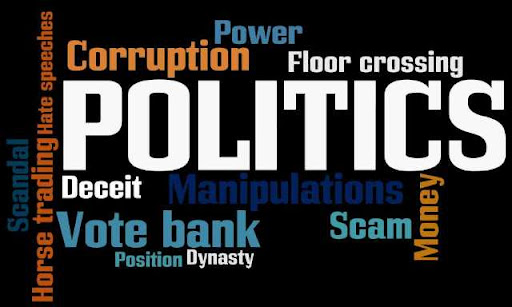
This post has been published by me as a team member of Indiana Legends for the SUPER 4 round of Bloggers Premier League (BPL) – The first ever unique, elite team blogging event of blog world. To catch the BPL action and also be part of future editions and other contests, visit and register at Cafe GingerChai.
Look at the above picture. What are the words that come to your mind when you think about Indian Politics? Chances are that the words mentioned in the picture are the ones you think about. The issue with Indians is that they think negatively about everything. They don't realize that Indian politics has 1 of the best value systems in the world! As they say "Beauty lies in the eyes of Beholder", we also need to look at Indian politics and politicians through a different viewpoint to see the values and morals they follow and the sacrifices they make.
In India it is believed that age is just a number. One should be young at heart. Same is believed by Indian politicians. Therefore we have people on the other side of 40 representing "youth" of India.
One of the biggest problems that India faces today is Corruption. The Indian govt acknowledges that and it has taken measures to eradicate corruption from the system. Therefore we have a PM who has absolutely no power. No power no corruption!
The Indian govt acknowledges the gender bias prevalent in the country and is working wholeheartedly to improve the condition of women. As a step forward for this process APJ Abdul Kalam was denied a second term and Pratibha patil was appointed the president of India. So what if she takes 100's of her relatives on tour with herself or her family is involved in various scams the govt is looking at the bigger picture here i.e. Women Empowerment while we worry about petty things.
One thing that is different in India from most other countries is that here elders are given due respect. It’s good to see that the same values are also followed by the politicians of India. Otherwise why would a Navin Jindal back "Khap panchayats" , who went to Supreme court for his right to hoist the national flag over his house! We may think that its all about vote bank politics but that's the difference between us and politicians. While we look for hidden motives they simply follow the values and morals.
Its always taught not to think bad even about your enemy. While we the mere mortals are not able to do that politicians not just do that they go 1 step further and help the enemy in times of need. That's why congress leaders joined hands with their enemies and helped them during the Gujarat riots!
Surprisingly our politicians also have very good knowledge about medical science. They know that genes and traits are carried forward from 1 generation to another. So we may keep thinking that its dynasty politics but the truth is that they choose the best candidate available for the job. Sadly they also have some misconceptions about it. One of them is that communalism is a communicable disease! Maybe they got confused between the similar sounding words. That why many politicians stayed away from Amitabh bachchan after he endorsed Gujarat (the state which is believed to be affected by this particular disease!).
"Atithi Devo Bhava" the literal meaning of this phrase is that Guest is just like god. Indians truly believe in this phrase. That's why whether it’s a Kasab or an Anderson all are provided with utmost comfort during there stay in India. In case the person wishes to leave he is provided with a government plane and if he decides to stay back crores are spent so that he gets the luxuries of his life. What’s more grateful is that the guests aren't required to pay from their pockets for the services. Since Indians believe in sharing the burden of others taxpayers take care of the expenses while the guests enjoy!
It’s not only the taxpayers who share the burden political parties and ministries also share the burden of each other. Otherwise why would NCP take it upon itself to educate people about the ill effects of eating sugar! That's the job of Health ministry. But in politics its all about helping each other.
Indian govt doesn't believe in geographical boundaries created by man. Therefore we have a MP who is not even an Indian! The govt also believes in giving second chance to the people. Therefore a person who has been banned for representing the country for life in a certain sport for match fixing can still become a MP and represent the country in a different way!
"B Positive". While the ordinary Indian came to know about this mantra after watching the movie "No Entry", Indian politicians were aware of it since long ago. Therefore whether its Bofors scandal, Black money or the Bhopal gas tragedy Indian govt doesn't worry much and is always positive about these issues!
There are uncountable examples to talk about when it comes to principles followed by Indian politicians. But a post about Indian politics cannot be completed without talking about the people because a democracy is government of the people, by the people, for the people.
Just like the politicians Indian people also have many good qualities. One of them is lack of unreasonable pride. Unlike others they don't believe that only they can make a good decision. Also they trust fellow Indians and respect their decisions. To show these qualities most Indians give their counterparts a chance to decide the government while they sacrifice their right to vote for some unimportant stuff like watching movies, sleep etc. Therefore it’s no surprise that the politicians that are chosen reflect the qualities the general people have.